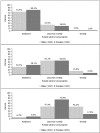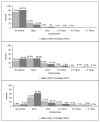Frequency, course and correlates of alcohol use from adolescence to young adulthood in a Swiss community survey
- PMID: 18201383
- PMCID: PMC2253536
- DOI: 10.1186/1471-244X-8-5
Frequency, course and correlates of alcohol use from adolescence to young adulthood in a Swiss community survey
Erratum in
- BMC Psychiatry. 2010;10:15
Abstract
Background: Few studies have analyzed the frequency of alcohol use across time from adolescence to young adulthood and its outcome in young adulthood. A Swiss longitudinal multilevel assessment project using various measures of psychopathology and psychosocial variables allowed for the study of the frequency and correlates of alcohol use so that this developmental trajectory may be better understood.
Method: Alcohol use was studied by a questionnaire in a cohort of N = 593 subjects who had been assessed at three times between adolescence and young adulthood within the Zurich Psychology and Psychopathology Study (ZAPPS). Other assessment included questionnaire data measuring emotional and behavioural problems, life events, coping style, self-related cognitions, perceived parenting style and school environment, and size and efficiency of the social network.
Results: The increase of alcohol use from early adolescence to young adulthood showed only a few sex-specific differences in terms of the amount of alcohol consumption and the motives to drink. In late adolescence and young adulthood, males had a higher amount of alcohol consumption and were more frequently looking for drunkenness and feeling high. Males also experienced more negative consequences of alcohol use. A subgroup of heavy or problem drinkers showed a large range of emotional and behavioural problems and further indicators of impaired psychosocial functioning both in late adolescence and young adulthood.
Conclusion: This Swiss community survey documents that alcohol use is problematic in a sizeable proportion of youth and goes hand in hand with a large number of psychosocial problems.
Figures





Similar articles
-
Continuity, psychosocial correlates, and outcome of problematic substance use from adolescence to young adulthood in a community sample.Child Adolesc Psychiatry Ment Health. 2007 Oct 11;1(1):12. doi: 10.1186/1753-2000-1-12. Child Adolesc Psychiatry Ment Health. 2007. PMID: 17931415 Free PMC article.
-
Problem coping skills, psychosocial adversities and mental health problems in children and adolescents as predictors of criminal outcomes in young adulthood.Eur Child Adolesc Psychiatry. 2014 May;23(5):283-93. doi: 10.1007/s00787-013-0458-y. Epub 2013 Aug 15. Eur Child Adolesc Psychiatry. 2014. PMID: 23949100
-
Developmental psychopathology in adolescence: findings from a Swiss study--the NAPE Lecture 2005.Acta Psychiatr Scand. 2006 Jan;113(1):6-12. doi: 10.1111/j.1600-0447.2005.00706.x. Acta Psychiatr Scand. 2006. PMID: 16390363
-
Gender differences in factors influencing alcohol use and drinking progression among adolescents.Clin Psychol Rev. 2009 Aug;29(6):535-47. doi: 10.1016/j.cpr.2009.06.003. Epub 2009 Jun 11. Clin Psychol Rev. 2009. PMID: 19592147 Free PMC article. Review.
-
A developmental perspective on alcohol use and heavy drinking during adolescence and the transition to young adulthood.J Stud Alcohol Suppl. 2002 Mar;(14):54-70. doi: 10.15288/jsas.2002.s14.54. J Stud Alcohol Suppl. 2002. PMID: 12022730 Review.
Cited by
-
The early health consequences of smoking: relationship with psychosocial factors among treatment-seeking Black smokers.Nicotine Tob Res. 2009 May;11(5):564-71. doi: 10.1093/ntr/ntp043. Epub 2009 Apr 9. Nicotine Tob Res. 2009. PMID: 19359391 Free PMC article.
-
Alcohol confounds relationship between cannabis misuse and psychosis conversion in a high-risk sample.Acta Psychiatr Scand. 2015 Jul;132(1):60-8. doi: 10.1111/acps.12382. Epub 2015 Jan 9. Acta Psychiatr Scand. 2015. PMID: 25572323 Free PMC article.
-
Genetic and environmental predictors of latent trajectories of alcohol use from adolescence to adulthood: a male twin study.Alcohol Clin Exp Res. 2013 Mar;37(3):498-506. doi: 10.1111/j.1530-0277.2012.01939.x. Epub 2013 Jan 24. Alcohol Clin Exp Res. 2013. PMID: 23347157 Free PMC article.
-
Chronic psychosocial stressors and salivary biomarkers in emerging adults.Psychoneuroendocrinology. 2012 Aug;37(8):1158-70. doi: 10.1016/j.psyneuen.2011.11.010. Epub 2011 Dec 14. Psychoneuroendocrinology. 2012. PMID: 22172638 Free PMC article. Clinical Trial.
-
Analysis of the alcohol drinking behavior and influencing factors among emerging adults and young adults: a cross-sectional study in Wuhan, China.BMC Public Health. 2019 Apr 30;19(1):458. doi: 10.1186/s12889-019-6831-0. BMC Public Health. 2019. PMID: 31039783 Free PMC article.
References
-
- Hibell B, Andersson B, Bjarnason T, Kokkevi A, Morgan M, Narusk A, Sweden: The Swedish Council for Information on Alcohol and other drugs. (CAN) / The Pompidou Group at the Council of Europe. The 1995 ESPAD report: Alcohol and other drug use among students in 26 European countries. Sweden , The Swedish Council for Information on Alcohol and other drugs. (CAN) / The Pompidou Group at the Council of Europe.; 1997.
-
- Perkonigg A, Pfister H, Höfler M, Fröhlich C, Zimmermann P, Lieb R, Wittchen HU. Substance Use and Substance Use Disorders in a Community Sample of Adolescents and Young Adults: Incidence, Age Effecs and Patterns of Use. European Addiction Research. 2006;12 - PubMed
-
- Schmid H, Delgrande J, Kuntsche EN, Kuendig H. Research report No 39 (in German) Lausanne, Switzerland , SFA-ISPA; 2003. Trends in the consumption of psycho-active substances among pupils in Switzerland - Selected findings from a study under the auspices of WHO.
Publication types
MeSH terms
LinkOut - more resources
Full Text Sources
Medical

